Critical Analysis Report: ECE306 Early Childhood Research Methods
VerifiedAdded on 2022/10/06
|8
|2194
|24
Report
AI Summary
This report presents a critical analysis of a qualitative research article focusing on modern curriculum innovation in a kindergarten located in China. The study investigated the features of school-based curriculum (SBC), the implementation strategies, and the underlying factors influencing its implementation. The researchers employed a qualitative research design, collecting data through interviews, classroom observations, and curriculum documentation. Data analysis involved axial and open coding. The findings revealed the influence of various factors on SBC, including the adoption of eclectic pedagogical methods and curriculum prototypes. The research indicated a shift towards child-centeredness and the integration of best practices. The study highlights the dynamic impact of global and local factors on curriculum development in Chinese kindergartens. The report critically assesses the research methods, findings, and conclusions, providing a comprehensive overview of the study's contributions to the field of early childhood education.
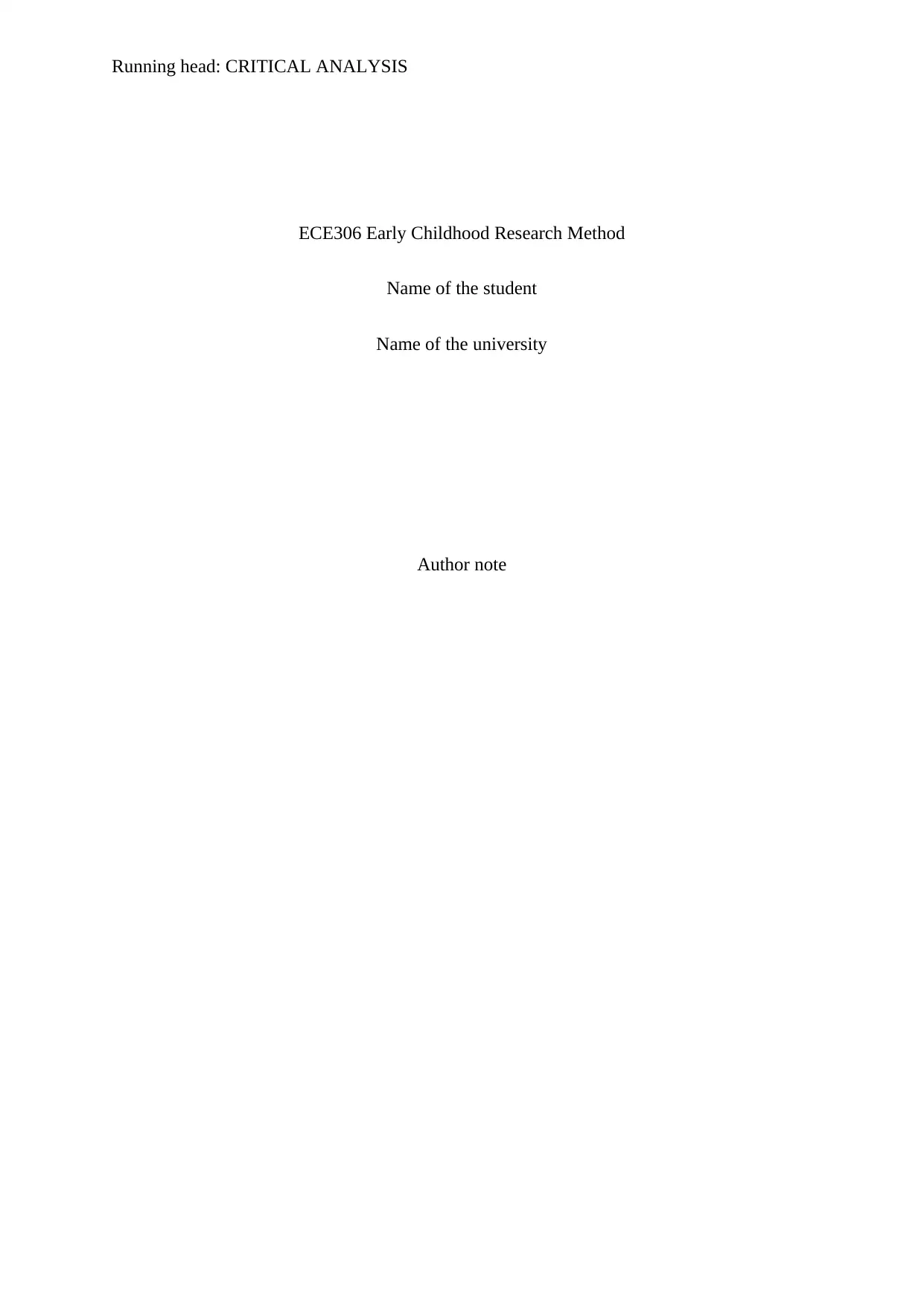
Running head: CRITICAL ANALYSIS
ECE306 Early Childhood Research Method
Name of the student
Name of the university
Author note
ECE306 Early Childhood Research Method
Name of the student
Name of the university
Author note
Paraphrase This Document
Need a fresh take? Get an instant paraphrase of this document with our AI Paraphraser
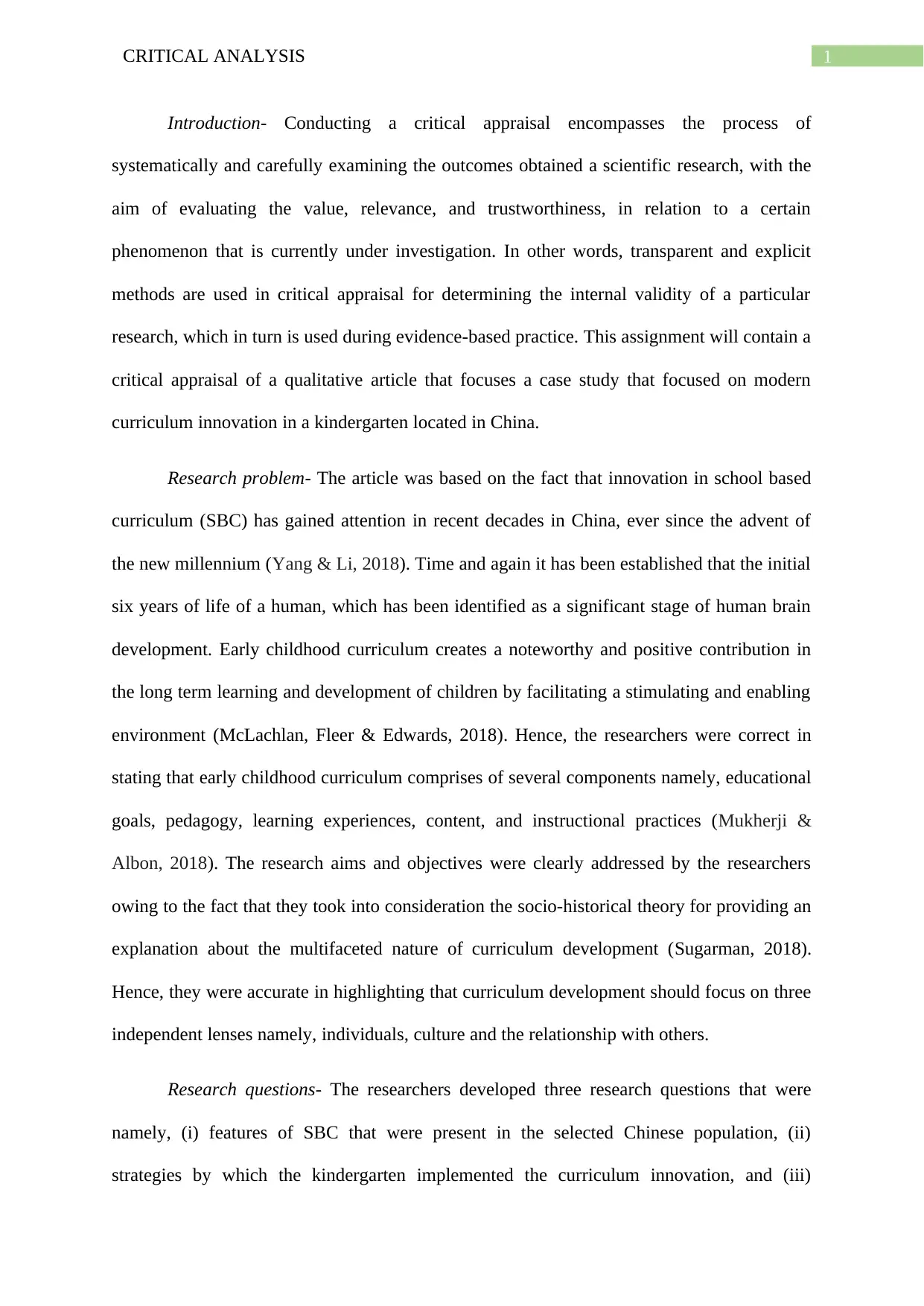
1CRITICAL ANALYSIS
Introduction- Conducting a critical appraisal encompasses the process of
systematically and carefully examining the outcomes obtained a scientific research, with the
aim of evaluating the value, relevance, and trustworthiness, in relation to a certain
phenomenon that is currently under investigation. In other words, transparent and explicit
methods are used in critical appraisal for determining the internal validity of a particular
research, which in turn is used during evidence-based practice. This assignment will contain a
critical appraisal of a qualitative article that focuses a case study that focused on modern
curriculum innovation in a kindergarten located in China.
Research problem- The article was based on the fact that innovation in school based
curriculum (SBC) has gained attention in recent decades in China, ever since the advent of
the new millennium (Yang & Li, 2018). Time and again it has been established that the initial
six years of life of a human, which has been identified as a significant stage of human brain
development. Early childhood curriculum creates a noteworthy and positive contribution in
the long term learning and development of children by facilitating a stimulating and enabling
environment (McLachlan, Fleer & Edwards, 2018). Hence, the researchers were correct in
stating that early childhood curriculum comprises of several components namely, educational
goals, pedagogy, learning experiences, content, and instructional practices (Mukherji &
Albon, 2018). The research aims and objectives were clearly addressed by the researchers
owing to the fact that they took into consideration the socio-historical theory for providing an
explanation about the multifaceted nature of curriculum development (Sugarman, 2018).
Hence, they were accurate in highlighting that curriculum development should focus on three
independent lenses namely, individuals, culture and the relationship with others.
Research questions- The researchers developed three research questions that were
namely, (i) features of SBC that were present in the selected Chinese population, (ii)
strategies by which the kindergarten implemented the curriculum innovation, and (iii)
Introduction- Conducting a critical appraisal encompasses the process of
systematically and carefully examining the outcomes obtained a scientific research, with the
aim of evaluating the value, relevance, and trustworthiness, in relation to a certain
phenomenon that is currently under investigation. In other words, transparent and explicit
methods are used in critical appraisal for determining the internal validity of a particular
research, which in turn is used during evidence-based practice. This assignment will contain a
critical appraisal of a qualitative article that focuses a case study that focused on modern
curriculum innovation in a kindergarten located in China.
Research problem- The article was based on the fact that innovation in school based
curriculum (SBC) has gained attention in recent decades in China, ever since the advent of
the new millennium (Yang & Li, 2018). Time and again it has been established that the initial
six years of life of a human, which has been identified as a significant stage of human brain
development. Early childhood curriculum creates a noteworthy and positive contribution in
the long term learning and development of children by facilitating a stimulating and enabling
environment (McLachlan, Fleer & Edwards, 2018). Hence, the researchers were correct in
stating that early childhood curriculum comprises of several components namely, educational
goals, pedagogy, learning experiences, content, and instructional practices (Mukherji &
Albon, 2018). The research aims and objectives were clearly addressed by the researchers
owing to the fact that they took into consideration the socio-historical theory for providing an
explanation about the multifaceted nature of curriculum development (Sugarman, 2018).
Hence, they were accurate in highlighting that curriculum development should focus on three
independent lenses namely, individuals, culture and the relationship with others.
Research questions- The researchers developed three research questions that were
namely, (i) features of SBC that were present in the selected Chinese population, (ii)
strategies by which the kindergarten implemented the curriculum innovation, and (iii)
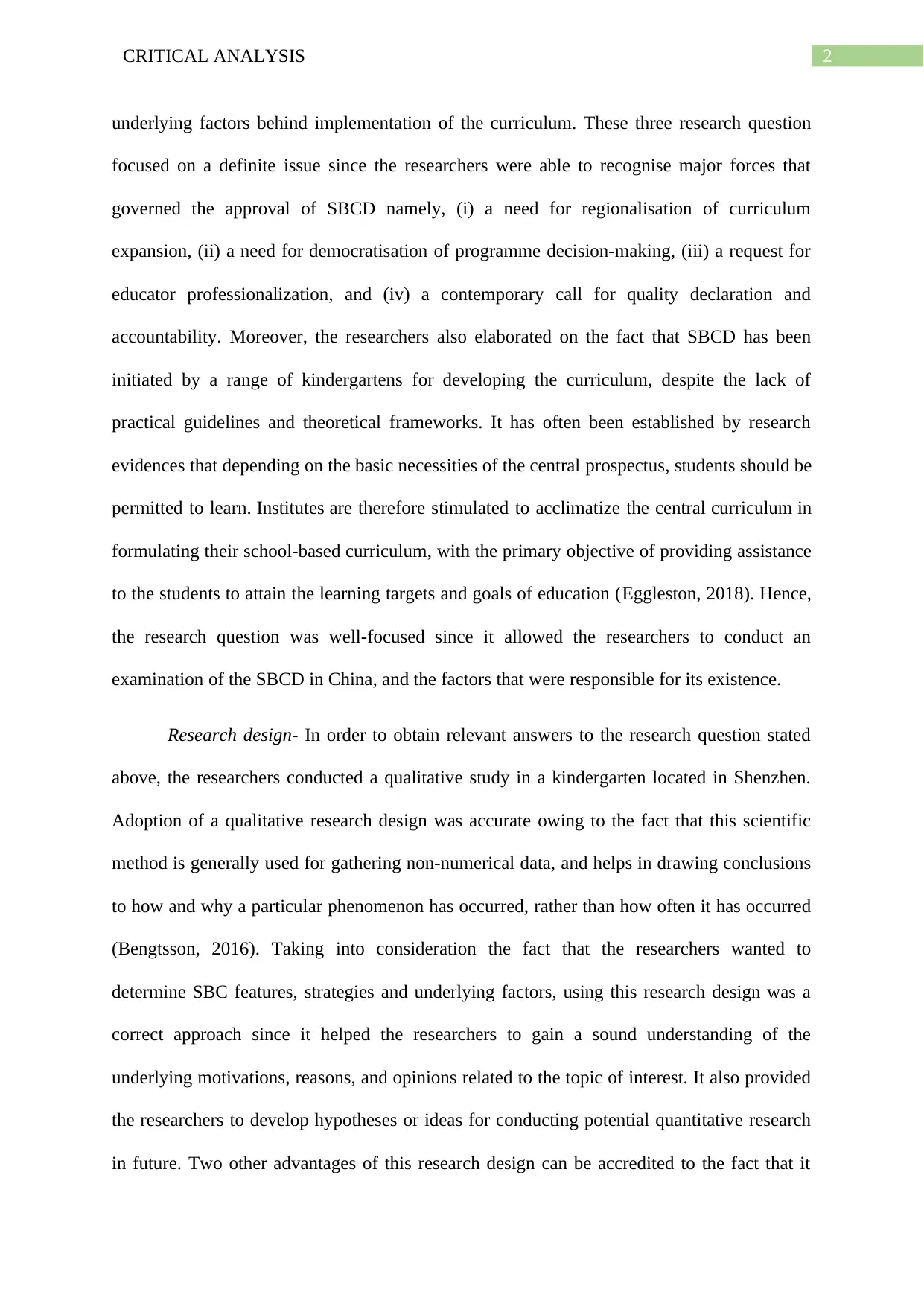
2CRITICAL ANALYSIS
underlying factors behind implementation of the curriculum. These three research question
focused on a definite issue since the researchers were able to recognise major forces that
governed the approval of SBCD namely, (i) a need for regionalisation of curriculum
expansion, (ii) a need for democratisation of programme decision-making, (iii) a request for
educator professionalization, and (iv) a contemporary call for quality declaration and
accountability. Moreover, the researchers also elaborated on the fact that SBCD has been
initiated by a range of kindergartens for developing the curriculum, despite the lack of
practical guidelines and theoretical frameworks. It has often been established by research
evidences that depending on the basic necessities of the central prospectus, students should be
permitted to learn. Institutes are therefore stimulated to acclimatize the central curriculum in
formulating their school-based curriculum, with the primary objective of providing assistance
to the students to attain the learning targets and goals of education (Eggleston, 2018). Hence,
the research question was well-focused since it allowed the researchers to conduct an
examination of the SBCD in China, and the factors that were responsible for its existence.
Research design- In order to obtain relevant answers to the research question stated
above, the researchers conducted a qualitative study in a kindergarten located in Shenzhen.
Adoption of a qualitative research design was accurate owing to the fact that this scientific
method is generally used for gathering non-numerical data, and helps in drawing conclusions
to how and why a particular phenomenon has occurred, rather than how often it has occurred
(Bengtsson, 2016). Taking into consideration the fact that the researchers wanted to
determine SBC features, strategies and underlying factors, using this research design was a
correct approach since it helped the researchers to gain a sound understanding of the
underlying motivations, reasons, and opinions related to the topic of interest. It also provided
the researchers to develop hypotheses or ideas for conducting potential quantitative research
in future. Two other advantages of this research design can be accredited to the fact that it
underlying factors behind implementation of the curriculum. These three research question
focused on a definite issue since the researchers were able to recognise major forces that
governed the approval of SBCD namely, (i) a need for regionalisation of curriculum
expansion, (ii) a need for democratisation of programme decision-making, (iii) a request for
educator professionalization, and (iv) a contemporary call for quality declaration and
accountability. Moreover, the researchers also elaborated on the fact that SBCD has been
initiated by a range of kindergartens for developing the curriculum, despite the lack of
practical guidelines and theoretical frameworks. It has often been established by research
evidences that depending on the basic necessities of the central prospectus, students should be
permitted to learn. Institutes are therefore stimulated to acclimatize the central curriculum in
formulating their school-based curriculum, with the primary objective of providing assistance
to the students to attain the learning targets and goals of education (Eggleston, 2018). Hence,
the research question was well-focused since it allowed the researchers to conduct an
examination of the SBCD in China, and the factors that were responsible for its existence.
Research design- In order to obtain relevant answers to the research question stated
above, the researchers conducted a qualitative study in a kindergarten located in Shenzhen.
Adoption of a qualitative research design was accurate owing to the fact that this scientific
method is generally used for gathering non-numerical data, and helps in drawing conclusions
to how and why a particular phenomenon has occurred, rather than how often it has occurred
(Bengtsson, 2016). Taking into consideration the fact that the researchers wanted to
determine SBC features, strategies and underlying factors, using this research design was a
correct approach since it helped the researchers to gain a sound understanding of the
underlying motivations, reasons, and opinions related to the topic of interest. It also provided
the researchers to develop hypotheses or ideas for conducting potential quantitative research
in future. Two other advantages of this research design can be accredited to the fact that it
⊘ This is a preview!⊘
Do you want full access?
Subscribe today to unlock all pages.

Trusted by 1+ million students worldwide
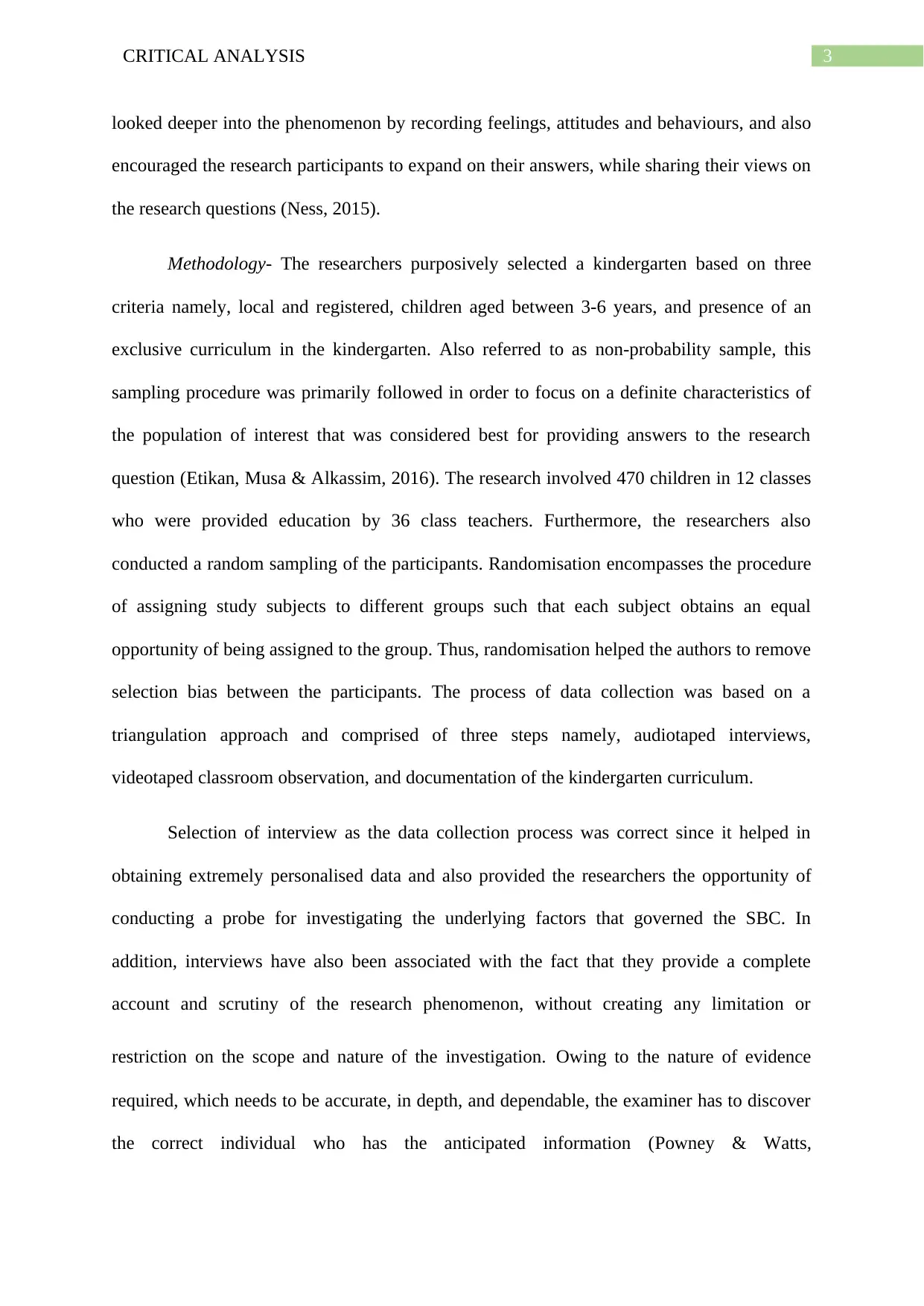
3CRITICAL ANALYSIS
looked deeper into the phenomenon by recording feelings, attitudes and behaviours, and also
encouraged the research participants to expand on their answers, while sharing their views on
the research questions (Ness, 2015).
Methodology- The researchers purposively selected a kindergarten based on three
criteria namely, local and registered, children aged between 3-6 years, and presence of an
exclusive curriculum in the kindergarten. Also referred to as non-probability sample, this
sampling procedure was primarily followed in order to focus on a definite characteristics of
the population of interest that was considered best for providing answers to the research
question (Etikan, Musa & Alkassim, 2016). The research involved 470 children in 12 classes
who were provided education by 36 class teachers. Furthermore, the researchers also
conducted a random sampling of the participants. Randomisation encompasses the procedure
of assigning study subjects to different groups such that each subject obtains an equal
opportunity of being assigned to the group. Thus, randomisation helped the authors to remove
selection bias between the participants. The process of data collection was based on a
triangulation approach and comprised of three steps namely, audiotaped interviews,
videotaped classroom observation, and documentation of the kindergarten curriculum.
Selection of interview as the data collection process was correct since it helped in
obtaining extremely personalised data and also provided the researchers the opportunity of
conducting a probe for investigating the underlying factors that governed the SBC. In
addition, interviews have also been associated with the fact that they provide a complete
account and scrutiny of the research phenomenon, without creating any limitation or
restriction on the scope and nature of the investigation. Owing to the nature of evidence
required, which needs to be accurate, in depth, and dependable, the examiner has to discover
the correct individual who has the anticipated information (Powney & Watts,
looked deeper into the phenomenon by recording feelings, attitudes and behaviours, and also
encouraged the research participants to expand on their answers, while sharing their views on
the research questions (Ness, 2015).
Methodology- The researchers purposively selected a kindergarten based on three
criteria namely, local and registered, children aged between 3-6 years, and presence of an
exclusive curriculum in the kindergarten. Also referred to as non-probability sample, this
sampling procedure was primarily followed in order to focus on a definite characteristics of
the population of interest that was considered best for providing answers to the research
question (Etikan, Musa & Alkassim, 2016). The research involved 470 children in 12 classes
who were provided education by 36 class teachers. Furthermore, the researchers also
conducted a random sampling of the participants. Randomisation encompasses the procedure
of assigning study subjects to different groups such that each subject obtains an equal
opportunity of being assigned to the group. Thus, randomisation helped the authors to remove
selection bias between the participants. The process of data collection was based on a
triangulation approach and comprised of three steps namely, audiotaped interviews,
videotaped classroom observation, and documentation of the kindergarten curriculum.
Selection of interview as the data collection process was correct since it helped in
obtaining extremely personalised data and also provided the researchers the opportunity of
conducting a probe for investigating the underlying factors that governed the SBC. In
addition, interviews have also been associated with the fact that they provide a complete
account and scrutiny of the research phenomenon, without creating any limitation or
restriction on the scope and nature of the investigation. Owing to the nature of evidence
required, which needs to be accurate, in depth, and dependable, the examiner has to discover
the correct individual who has the anticipated information (Powney & Watts,
Paraphrase This Document
Need a fresh take? Get an instant paraphrase of this document with our AI Paraphraser
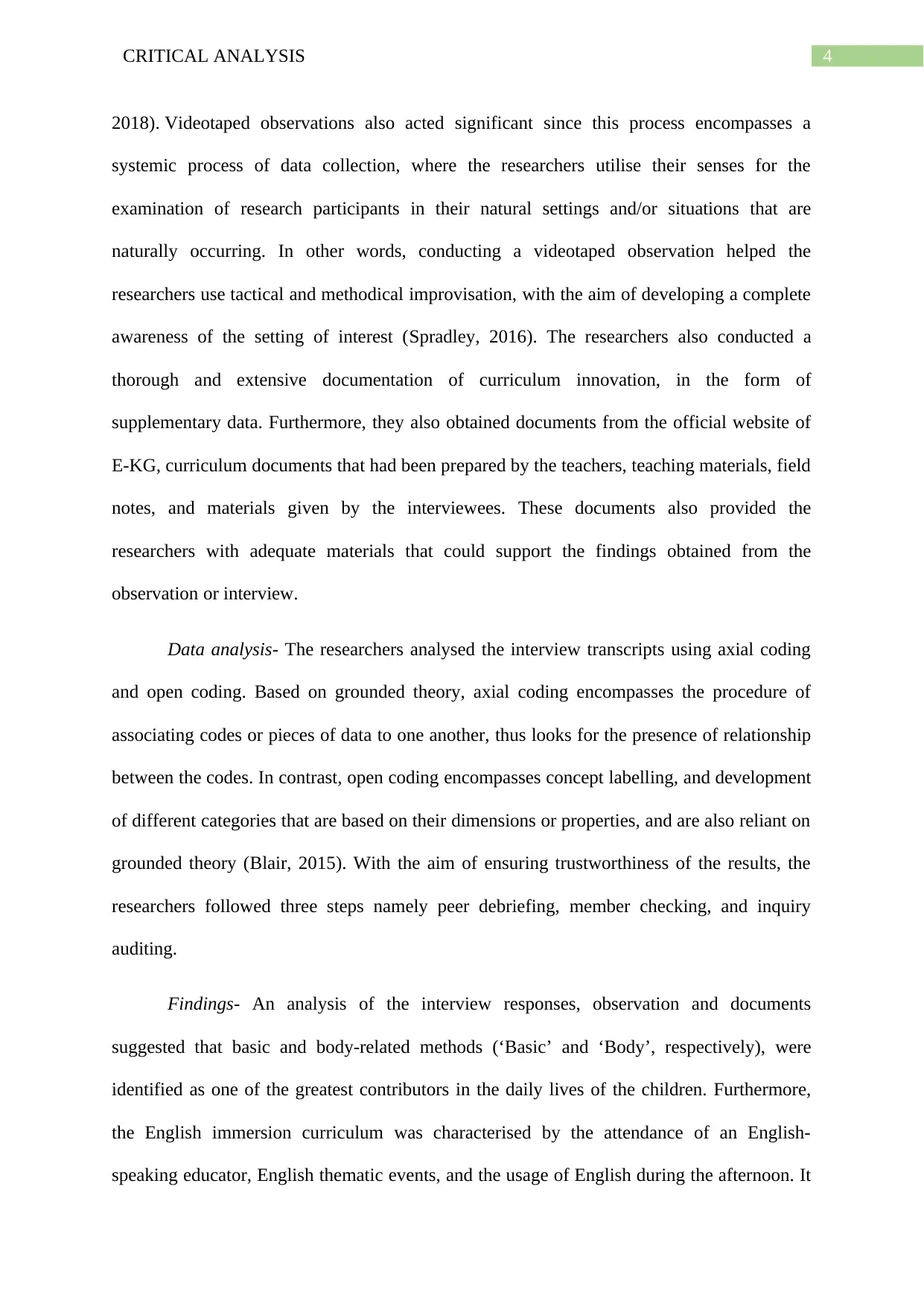
4CRITICAL ANALYSIS
2018). Videotaped observations also acted significant since this process encompasses a
systemic process of data collection, where the researchers utilise their senses for the
examination of research participants in their natural settings and/or situations that are
naturally occurring. In other words, conducting a videotaped observation helped the
researchers use tactical and methodical improvisation, with the aim of developing a complete
awareness of the setting of interest (Spradley, 2016). The researchers also conducted a
thorough and extensive documentation of curriculum innovation, in the form of
supplementary data. Furthermore, they also obtained documents from the official website of
E-KG, curriculum documents that had been prepared by the teachers, teaching materials, field
notes, and materials given by the interviewees. These documents also provided the
researchers with adequate materials that could support the findings obtained from the
observation or interview.
Data analysis- The researchers analysed the interview transcripts using axial coding
and open coding. Based on grounded theory, axial coding encompasses the procedure of
associating codes or pieces of data to one another, thus looks for the presence of relationship
between the codes. In contrast, open coding encompasses concept labelling, and development
of different categories that are based on their dimensions or properties, and are also reliant on
grounded theory (Blair, 2015). With the aim of ensuring trustworthiness of the results, the
researchers followed three steps namely peer debriefing, member checking, and inquiry
auditing.
Findings- An analysis of the interview responses, observation and documents
suggested that basic and body-related methods (‘Basic’ and ‘Body’, respectively), were
identified as one of the greatest contributors in the daily lives of the children. Furthermore,
the English immersion curriculum was characterised by the attendance of an English-
speaking educator, English thematic events, and the usage of English during the afternoon. It
2018). Videotaped observations also acted significant since this process encompasses a
systemic process of data collection, where the researchers utilise their senses for the
examination of research participants in their natural settings and/or situations that are
naturally occurring. In other words, conducting a videotaped observation helped the
researchers use tactical and methodical improvisation, with the aim of developing a complete
awareness of the setting of interest (Spradley, 2016). The researchers also conducted a
thorough and extensive documentation of curriculum innovation, in the form of
supplementary data. Furthermore, they also obtained documents from the official website of
E-KG, curriculum documents that had been prepared by the teachers, teaching materials, field
notes, and materials given by the interviewees. These documents also provided the
researchers with adequate materials that could support the findings obtained from the
observation or interview.
Data analysis- The researchers analysed the interview transcripts using axial coding
and open coding. Based on grounded theory, axial coding encompasses the procedure of
associating codes or pieces of data to one another, thus looks for the presence of relationship
between the codes. In contrast, open coding encompasses concept labelling, and development
of different categories that are based on their dimensions or properties, and are also reliant on
grounded theory (Blair, 2015). With the aim of ensuring trustworthiness of the results, the
researchers followed three steps namely peer debriefing, member checking, and inquiry
auditing.
Findings- An analysis of the interview responses, observation and documents
suggested that basic and body-related methods (‘Basic’ and ‘Body’, respectively), were
identified as one of the greatest contributors in the daily lives of the children. Furthermore,
the English immersion curriculum was characterised by the attendance of an English-
speaking educator, English thematic events, and the usage of English during the afternoon. It
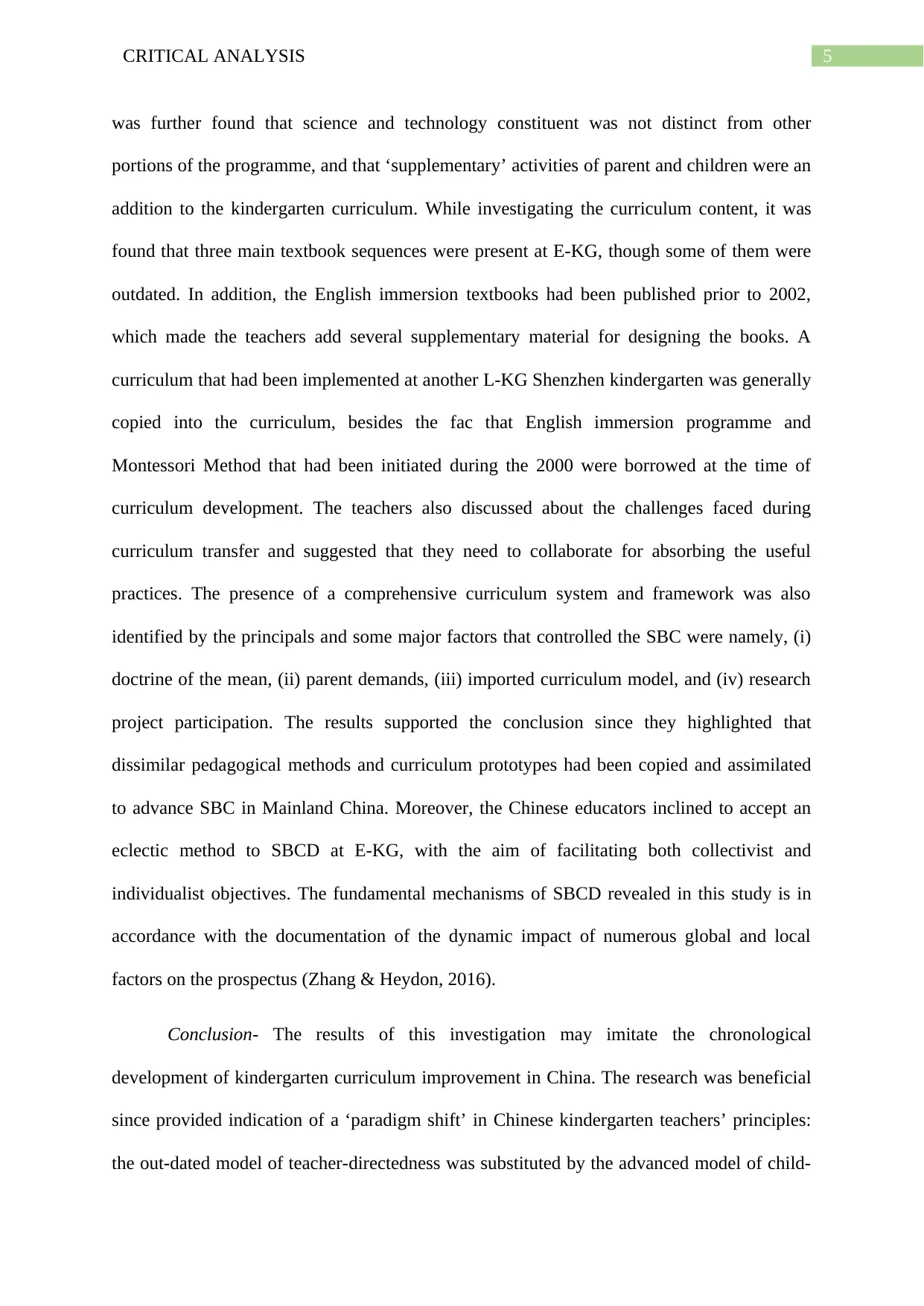
5CRITICAL ANALYSIS
was further found that science and technology constituent was not distinct from other
portions of the programme, and that ‘supplementary’ activities of parent and children were an
addition to the kindergarten curriculum. While investigating the curriculum content, it was
found that three main textbook sequences were present at E-KG, though some of them were
outdated. In addition, the English immersion textbooks had been published prior to 2002,
which made the teachers add several supplementary material for designing the books. A
curriculum that had been implemented at another L-KG Shenzhen kindergarten was generally
copied into the curriculum, besides the fac that English immersion programme and
Montessori Method that had been initiated during the 2000 were borrowed at the time of
curriculum development. The teachers also discussed about the challenges faced during
curriculum transfer and suggested that they need to collaborate for absorbing the useful
practices. The presence of a comprehensive curriculum system and framework was also
identified by the principals and some major factors that controlled the SBC were namely, (i)
doctrine of the mean, (ii) parent demands, (iii) imported curriculum model, and (iv) research
project participation. The results supported the conclusion since they highlighted that
dissimilar pedagogical methods and curriculum prototypes had been copied and assimilated
to advance SBC in Mainland China. Moreover, the Chinese educators inclined to accept an
eclectic method to SBCD at E-KG, with the aim of facilitating both collectivist and
individualist objectives. The fundamental mechanisms of SBCD revealed in this study is in
accordance with the documentation of the dynamic impact of numerous global and local
factors on the prospectus (Zhang & Heydon, 2016).
Conclusion- The results of this investigation may imitate the chronological
development of kindergarten curriculum improvement in China. The research was beneficial
since provided indication of a ‘paradigm shift’ in Chinese kindergarten teachers’ principles:
the out-dated model of teacher-directedness was substituted by the advanced model of child-
was further found that science and technology constituent was not distinct from other
portions of the programme, and that ‘supplementary’ activities of parent and children were an
addition to the kindergarten curriculum. While investigating the curriculum content, it was
found that three main textbook sequences were present at E-KG, though some of them were
outdated. In addition, the English immersion textbooks had been published prior to 2002,
which made the teachers add several supplementary material for designing the books. A
curriculum that had been implemented at another L-KG Shenzhen kindergarten was generally
copied into the curriculum, besides the fac that English immersion programme and
Montessori Method that had been initiated during the 2000 were borrowed at the time of
curriculum development. The teachers also discussed about the challenges faced during
curriculum transfer and suggested that they need to collaborate for absorbing the useful
practices. The presence of a comprehensive curriculum system and framework was also
identified by the principals and some major factors that controlled the SBC were namely, (i)
doctrine of the mean, (ii) parent demands, (iii) imported curriculum model, and (iv) research
project participation. The results supported the conclusion since they highlighted that
dissimilar pedagogical methods and curriculum prototypes had been copied and assimilated
to advance SBC in Mainland China. Moreover, the Chinese educators inclined to accept an
eclectic method to SBCD at E-KG, with the aim of facilitating both collectivist and
individualist objectives. The fundamental mechanisms of SBCD revealed in this study is in
accordance with the documentation of the dynamic impact of numerous global and local
factors on the prospectus (Zhang & Heydon, 2016).
Conclusion- The results of this investigation may imitate the chronological
development of kindergarten curriculum improvement in China. The research was beneficial
since provided indication of a ‘paradigm shift’ in Chinese kindergarten teachers’ principles:
the out-dated model of teacher-directedness was substituted by the advanced model of child-
⊘ This is a preview!⊘
Do you want full access?
Subscribe today to unlock all pages.

Trusted by 1+ million students worldwide
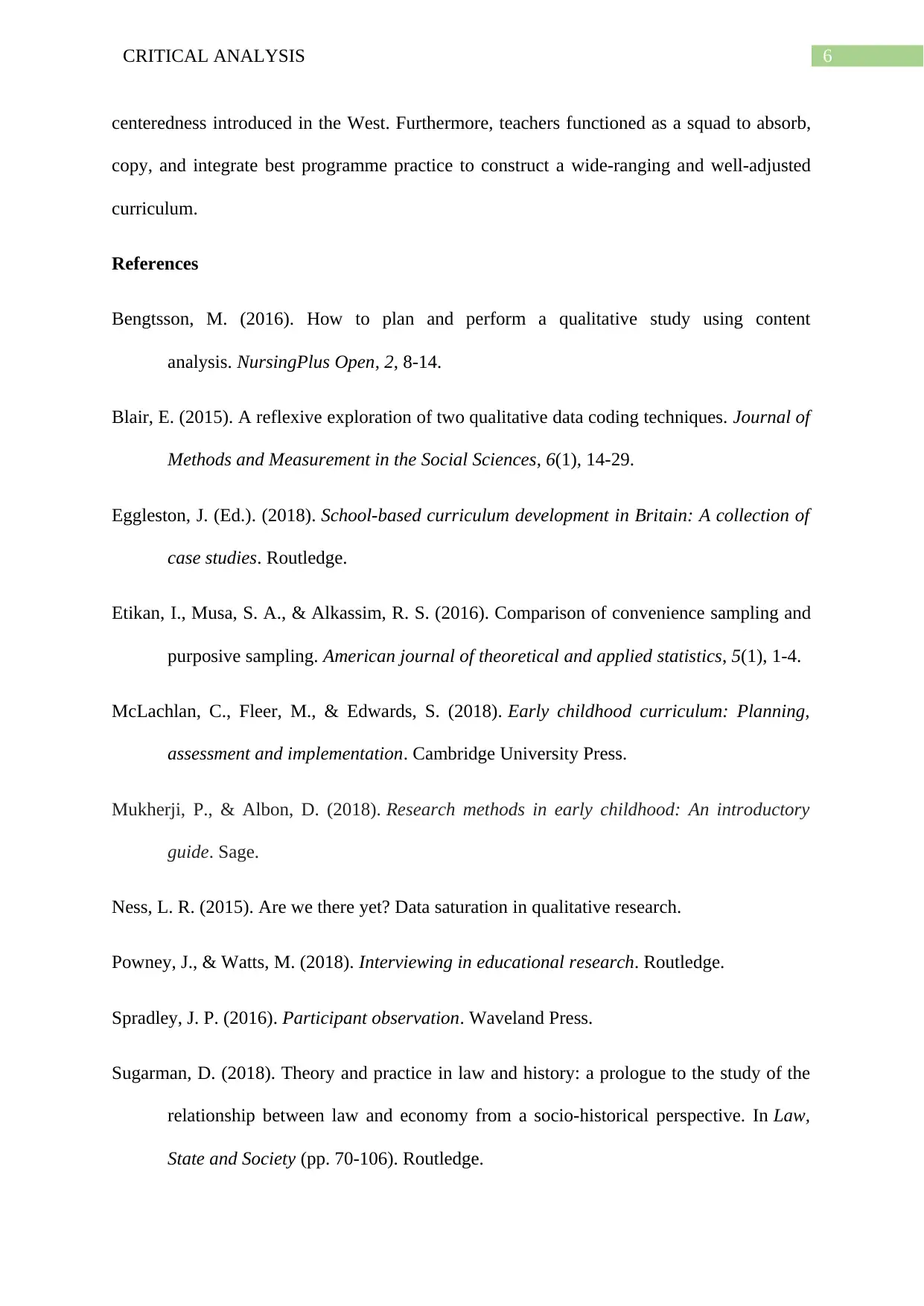
6CRITICAL ANALYSIS
centeredness introduced in the West. Furthermore, teachers functioned as a squad to absorb,
copy, and integrate best programme practice to construct a wide-ranging and well-adjusted
curriculum.
References
Bengtsson, M. (2016). How to plan and perform a qualitative study using content
analysis. NursingPlus Open, 2, 8-14.
Blair, E. (2015). A reflexive exploration of two qualitative data coding techniques. Journal of
Methods and Measurement in the Social Sciences, 6(1), 14-29.
Eggleston, J. (Ed.). (2018). School-based curriculum development in Britain: A collection of
case studies. Routledge.
Etikan, I., Musa, S. A., & Alkassim, R. S. (2016). Comparison of convenience sampling and
purposive sampling. American journal of theoretical and applied statistics, 5(1), 1-4.
McLachlan, C., Fleer, M., & Edwards, S. (2018). Early childhood curriculum: Planning,
assessment and implementation. Cambridge University Press.
Mukherji, P., & Albon, D. (2018). Research methods in early childhood: An introductory
guide. Sage.
Ness, L. R. (2015). Are we there yet? Data saturation in qualitative research.
Powney, J., & Watts, M. (2018). Interviewing in educational research. Routledge.
Spradley, J. P. (2016). Participant observation. Waveland Press.
Sugarman, D. (2018). Theory and practice in law and history: a prologue to the study of the
relationship between law and economy from a socio-historical perspective. In Law,
State and Society (pp. 70-106). Routledge.
centeredness introduced in the West. Furthermore, teachers functioned as a squad to absorb,
copy, and integrate best programme practice to construct a wide-ranging and well-adjusted
curriculum.
References
Bengtsson, M. (2016). How to plan and perform a qualitative study using content
analysis. NursingPlus Open, 2, 8-14.
Blair, E. (2015). A reflexive exploration of two qualitative data coding techniques. Journal of
Methods and Measurement in the Social Sciences, 6(1), 14-29.
Eggleston, J. (Ed.). (2018). School-based curriculum development in Britain: A collection of
case studies. Routledge.
Etikan, I., Musa, S. A., & Alkassim, R. S. (2016). Comparison of convenience sampling and
purposive sampling. American journal of theoretical and applied statistics, 5(1), 1-4.
McLachlan, C., Fleer, M., & Edwards, S. (2018). Early childhood curriculum: Planning,
assessment and implementation. Cambridge University Press.
Mukherji, P., & Albon, D. (2018). Research methods in early childhood: An introductory
guide. Sage.
Ness, L. R. (2015). Are we there yet? Data saturation in qualitative research.
Powney, J., & Watts, M. (2018). Interviewing in educational research. Routledge.
Spradley, J. P. (2016). Participant observation. Waveland Press.
Sugarman, D. (2018). Theory and practice in law and history: a prologue to the study of the
relationship between law and economy from a socio-historical perspective. In Law,
State and Society (pp. 70-106). Routledge.
Paraphrase This Document
Need a fresh take? Get an instant paraphrase of this document with our AI Paraphraser
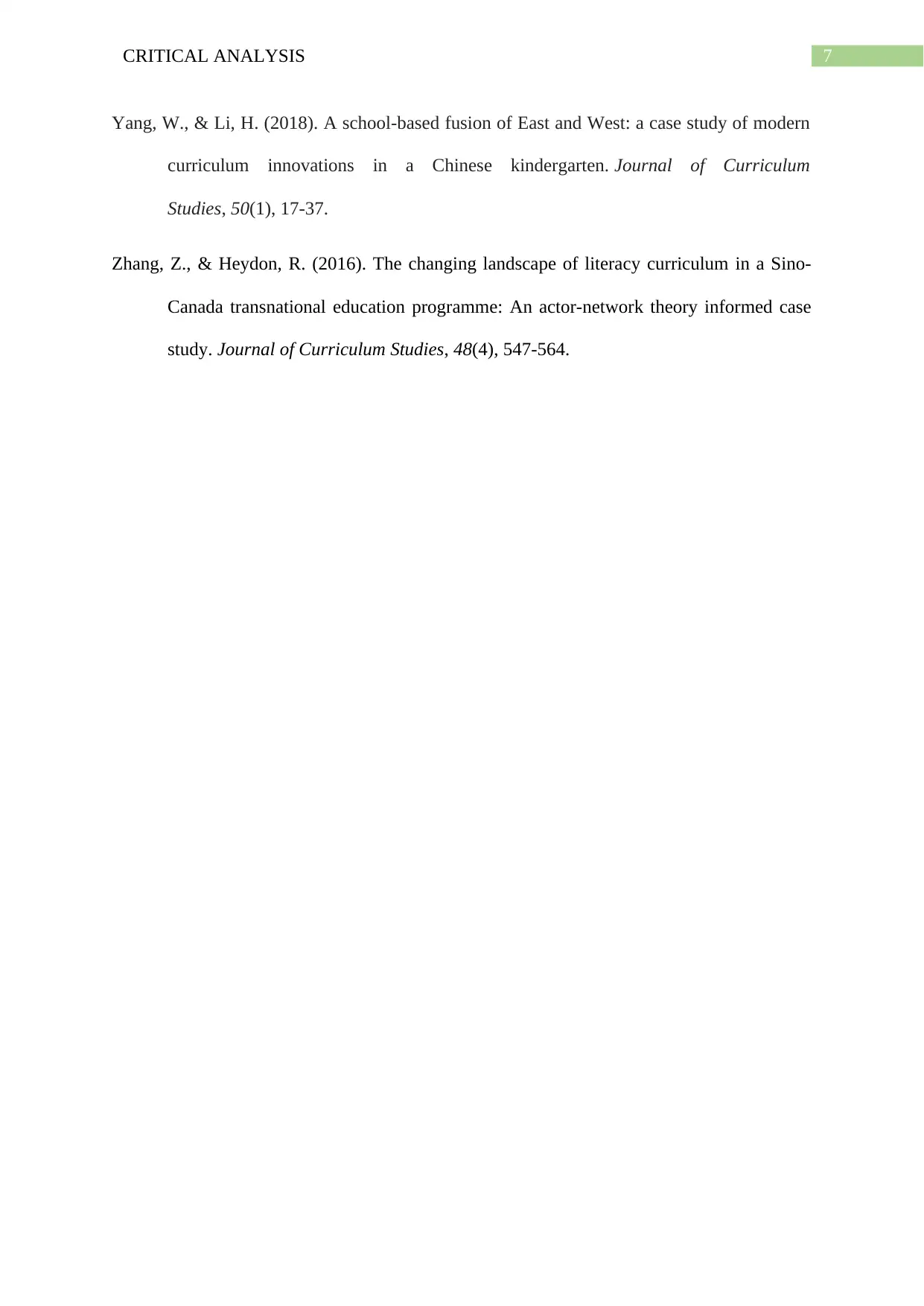
7CRITICAL ANALYSIS
Yang, W., & Li, H. (2018). A school-based fusion of East and West: a case study of modern
curriculum innovations in a Chinese kindergarten. Journal of Curriculum
Studies, 50(1), 17-37.
Zhang, Z., & Heydon, R. (2016). The changing landscape of literacy curriculum in a Sino-
Canada transnational education programme: An actor-network theory informed case
study. Journal of Curriculum Studies, 48(4), 547-564.
Yang, W., & Li, H. (2018). A school-based fusion of East and West: a case study of modern
curriculum innovations in a Chinese kindergarten. Journal of Curriculum
Studies, 50(1), 17-37.
Zhang, Z., & Heydon, R. (2016). The changing landscape of literacy curriculum in a Sino-
Canada transnational education programme: An actor-network theory informed case
study. Journal of Curriculum Studies, 48(4), 547-564.
1 out of 8
Related Documents
Your All-in-One AI-Powered Toolkit for Academic Success.
+13062052269
info@desklib.com
Available 24*7 on WhatsApp / Email
![[object Object]](/_next/static/media/star-bottom.7253800d.svg)
Unlock your academic potential
Copyright © 2020–2025 A2Z Services. All Rights Reserved. Developed and managed by ZUCOL.





